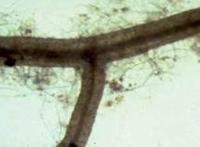What are Microorganisms?
Microorganisms are groups of very small organisms for which the soil is the natural habitat, and which may include groups such as bacteria, fungi, protozoans, algae, and actinomycetes. The organisms play crucial roles in soil formation, soil structure, fertility, aeration, and drainage.
| Title | Source | Resource type and Date | Short Summary / Preview |
|---|---|---|---|
| Purdue Soil Health Education website | Purdue Soil Health Education Website | Video
Sep 2017 |
Dr. John Graveel, Purdue Agronomy Department discusses microbiology activity within soils. |
| The ABCs of Soil Health | USDA | NRCS Slideshow
not dated |
Example: “M is for Microbes”, There are more MICROBES in one teaspoon of healthy soil than people on the Earth. |
| Understanding Soil Microbes and Nutrient Recycling | Ohio State University | Extension Webpage
Sep 2010 |
The role of microbes in nutrient cycling and soil health. |
| Microbes Crucial to Long-Term Soil Health | Michigan State University | Research summary
2015 |
Summary of research on soil health and the role of microbes from the MSU Kellogg Biological Station Long-Term Ecological Research (LTER) program. |
| Soil Microorganisms | SARE | Extension Webpage
2012 |
Microorganisms are very small forms of life that can sometimes live as single cells, although many also form colonies of cells. |
| The Science of Soil Health: Changing the Way we Think about Soil Microbes | USDA NRCS | Video
Feb 2014 |
Dr. Kristine Nichols, Soil Microbiologist, Agricultural Research Services, Mandan ND discusses soil microbes within the context of soil health – NRCS video. |
| The Science of Soil Health: Fighting Plant Disease with Microbes | USDA NRCS | Video
Jul 2014 |
Video series entitled “Unlock the Science of Soil Health” The Science of Soil Health: Fighting Plant Disease with Microbes featuring Dr. Geoff Zehnder, Professor of Entomology, Coordinator of IPM and Sustainable Agriculture, Clemson University. |
| PLFA video protocol | JoVE from University of Wisconsin-Madison Researchers | Video
2017 |
This video protocol explains how phospholipid fatty acid analysis is done and how to interpret the data. |
| Title | Source | Resource type and date | Short Summary |
|---|---|---|---|
| Building Healthy Soils | University of Tennessee | Extension Fact Sheet
Sep 2012 |
Many different types of organisms living in soils provide valuable services. Microorganisms, such as bacteria and fungi, support plant fertility by assisting with the release of minerals bound up in soil organic matter. |
| Title | Source | Resource type and Date | Short Summary |
|---|---|---|---|
| The role of microarthropods in emerging models of soil organic matter | Soil Biology and Biochemistry | Peer-Reviewed Publication
Nov 2016 |
Research paper summarizing how microarthropods affect soil organic matter dynamics. |
| Evaluation of methods to estimate the soil microbial biomass and the relationship with soil texture and organic matter | Soil Biology and Biochemistry | Peer-Reviewed Publication
Jul 1992 |
Tested different methods to measure soil microbial biomass. Biomass and activity of the soil microflora were significantly related to clay, soil organic C and especially to total N content. |
| Soil health—a new challenge for microbiologists and chemists | International Microbiology | Peer-Reviewed Publication
Jan 2005 |
One of the key objectives in determining soil health is to acquire indicators that can be used to evaluate the soil’s current status and hence to develop sustainable agricultural systems. In this regard, significant progress has been made over the last few years in the development of specific bio-markers and macromolecular probes, enabling rapid and reliable measurements of soil microbial communities. |
| Microorganisms:, Global Soil Biodiversity Atlas | ePublications Office of the European Union | Book
May 2016 |
Soil biodiversity is crucial to soil health and microorganisms play a role in that biodiversity. |
| Importance of Soil Temperature for the Growth of Temperate Crops under a Tropical Climate and Functional Role of Soil Microbial Diversity | Microbes and Environments | Peer-Reviewed Publication
Apr 2018 |
Soil temperature closely correlates with the growth of temperate crops, and affects plant processes and soil microbial diversity. The present study focuses on the effects of soil temperatures on lettuce growth and soil microbial diversity that maintains the growth of lettuce at low soil temperatures. |
| Microbial Biomass C, N | Michigan State University, LTER | Extension / Research Protocol
Not Dated |
Protocol to measure microbial biomass in the soil. |
| Equations for Soil Microbial Biovolume and Carbon Calculation | Michigan State University, LTER | Extension / Research Protocol
Not Dated |
The equations for calculation of soil microbial biovolume and carbon are specified. |
Last reviewed 10/24/19
